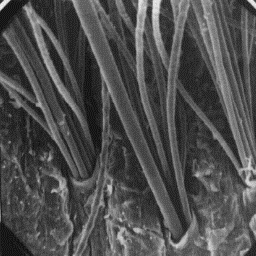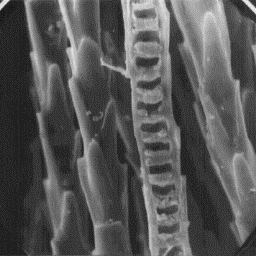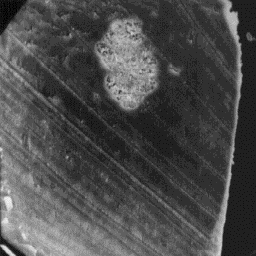 Otaria byronia
Otaria byronia
--------------
English: South american sealion
German: M„hnenrobbe
French: Otarie acriniere
Spanish: Otaria du sudam‚rica
Distribution areas
------------------
The south american sealion lives on the
coasts of South America from the La Plata
river, around Cape Horn to Peru, and on the
Falkland and Juan-Fernandez islands.
Description of the fur
---------------------- The surface structure
The skins are from 190 to 245 cm long an of the skin, 300x
dark brown in colour, the belly are is
yellow-brown. The hair fibres are straight and dense. The undercoat is light
red-brown in colour and about 10 mm thick. The lustrous guard hairs are up to
20 mm long, and even more on the neck, where it forms a distinctive mane.
|
|
 Otaria byronia
Otaria byronia
--------------
English: South american sealion
German: M„hnenrobbe
French: Otarie acriniere
Spanish: Otaria du sudam‚rica
Structure of the hair
---------------------
The microscopic structure of the skin
surface is usually smooth; the hair
follicles are narrow with raised edges. The
follicles contain cluster of the hair
shafts.
The fine fur fibres are circular and Longitudinal section
elliptical in cross-section with a diameter of a fine fur fibre, 1000x
of 10 to 18 µm. The cuticular scales are
petal-like with a smooth scale surface and straight margins. These fibres
have a wide medulla which is unbroken and central symmetrical-shaped in
cross-section. The overall type of the medulla is of the uniserial ladder
shape. The infilling material in the medullary column is either of the
granular or amorphous detailed structure.
|
|
 Otaria byronia
Otaria byronia
--------------
English: South american sealion
German: M„hnenrobbe
French: Otarie acriniere
Spanish: Otaria du sudam‚rica
The intermediate fibres are elliptical
in cross-section with a diameter of 50 to
90 µm. The cuticular scales are wavelike
with a smooth surface and straight scale
margins. The medulla is wide, unbroken and
central symmetrical-shaped in cross-section.
The medulla is of the lattice type with a
sheet-like infilling material.
Transverse section
The guard hairs are elliptical and the of an intermediate fibre, 400x
diameter of these fibres ranges from 90 to
130 µm. The cuticular scales are of the even, tile-like type with a smooth
scale surface and straight margins. The medulla is narrow and of the needle
-like type. It is unbroken and central symmetrical-shaped in cross-section.
The infilling medullar substance is of the fibrous detailed structure.
|
|
 Otaria byronia
Otaria byronia
--------------
English: South american sealion
German: M„hnenrobbe
French: Otarie acriniere
Spanish: Otaria du sudam‚rica
Transverse section
of a guard hair, 400x
|
|
 Otaria byronia
Otaria byronia
--------------
English: South american sealion
German: M„hnenrobbe
French: Otarie acriniere
Spanish: Otaria du sudam‚rica
Detailed structure
of the medulla, 4000x
Numerical code for south american sealion skin structure
------------------------------------------------------
Surface of the skin: 1-5-3
Fine fur fibres: 1.2-11-1-1-2-1-1-1-8.6-10.18-6.11
Intermediate fibres: 2-7-1-1-2-1-1-8-1-50.91-8.13
Guard hairs: 2-2-1-1-3-1-1-15-7-90.131-10.21
|




